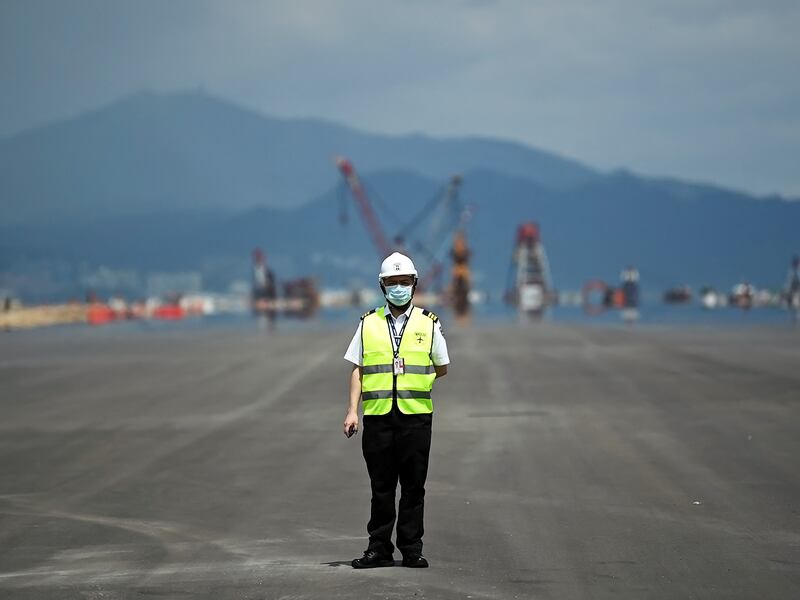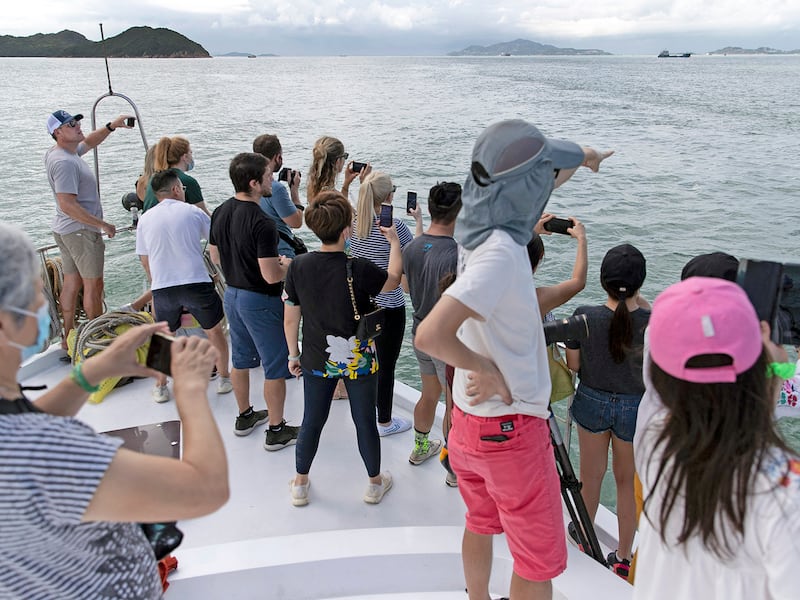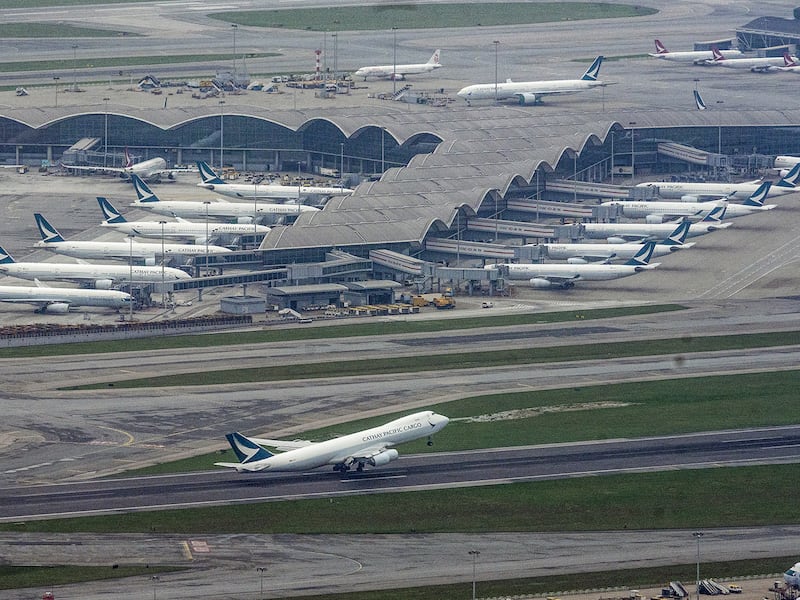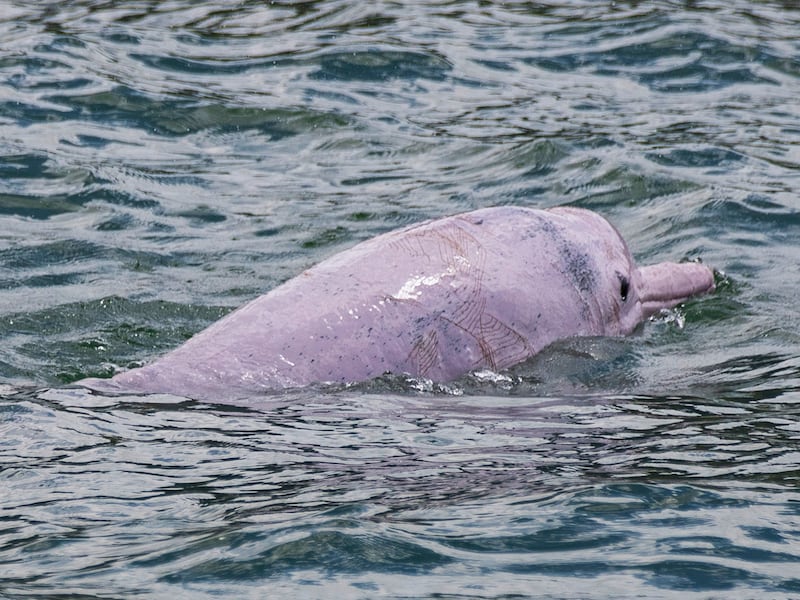Hong Kong’s iconic pink dolphins have dwindled to just a handful in the waters off northern Lantau Island in recent years, with concerns for the animals' future since the city’s international airport added a third runway, researchers told RFA Mandarin.
The endangered animals, a local variant of the Indo-Pacific humpback dolphin, a species also known as the Chinese white dolphin, were once chosen as the mascot for Hong Kong’s 1997 handover to Chinese rule, Hong Kong Dolphin Conservation Project researcher Viena Mak said in a recent interview.
But their numbers have plummeted in the past decade, researchers say, despite a brief rebound during the COVID-19 travel restrictions that started in 2020.
Before the construction of the airport at Chek Lap Kok, the waters around Hong Kong’s outlying Lantau Island were teeming with marine life, with 188 pink dolphins counted in 2003, 102 of which were off North Lantau, where the airport now lies.

Now, researchers estimate that just three or four pink dolphins still live in the area.
Even more worryingly, just 10 days after the city’s US$18.5 billion third runway became operational, a pink dolphin was found beached and dead nearby, Mak said.
“It was a mother who had just given birth,” she said. “We had been observing it at sea in October and were able to take pictures of the mother and the baby.”
Mak said she feared the infant wouldn’t survive, as they usually need a mother’s care until they are one or two years old, and can forage independently for food.
Vulnerable species
The Chinese white dolphin is on the Red List of Endangered Species of the International Union for Conservation of Nature, where it is listed as vulnerable.
Their habitat was greatly disturbed by the massive land reclamation that took place in the waters off northern Lantau Island to build Hong Kong’s International Airport at Chek Lap Kok, and sightings of the dolphins have become extremely rare in that part of the city’s coastal waters, according to the Hong Kong Dolphin Conservation Project, which has been monitoring them since before the handover.
In the first year of the airport’s expansion in 2016, just 11 dolphins were recorded north of Lantau. By the time the third runway was completed in 2020, researchers could only find three, although four were spotted last year, Mak said.
RELATED STORIES
Hong Kong’s tech city will destroy key wetland for birds: experts
Hong Kong plans to loosen laws to allow more reclamation of Victoria Harbour
Hong Kong culls wild boar after police officer attack
One of them has been named “Snowy,” although she’s known in official records simply as NL104.
“That means she’s the 104th pink dolphin to be identified in the waters off Lantau,” Mak said. “She has had three births, one of which was in October 2011. We also saw her with her baby in 2015.”
Government figures back up the Conservation Project’s findings.

Hong Kong was home to just 34 pink dolphins in 2023, down from 47 in 2017, according to a survey by the city’s Department of Agriculture, Fisheries and Conservation.
“Large declines in dolphin abundance were detected over the past two decades in both Northeast Lantau and Northwest Lantau survey areas, and noticeable decline was also detected in West Lantau waters but has stabilized in recent years,” the report said.
Increase in casualties
Dolphins are increasingly showing up as casualties following increased activity in the area, Mak said, although the reason isn’t entirely clear.
Five dolphins were beached in 2016, rising to eight in 2018, and 11 in 2020, although there has been a slight fall since then.
“We’re not exactly sure what happened to these dolphins, and why they were found beached in Hong Kong, but it is a cause for concern,” Mak said. “Numbers at sea fell during the same period that the numbers found beached increased.”

Some of the dolphins have moved elsewhere, she said.
“We found that shortly after the third runway project started, they moved to different places, from the waters of North Lantau to West Lantau and Southwest Lantau,” Mak told RFA Mandarin. “Now that the project is completed, they don’t go back there often.”
“It’s no longer the paradise it used to be ... and some of the older dolphins know this very well,” she said.
Move brings risks
The move to unfamiliar waters brings with it greater survival pressures, as the animals come into contact with other human activities like shipping, high-speed ferries and fishing. Once in their new habitat, they then compete with the other dolphins for food.
Part of the problem is that the runway was built around 1 kilometer (.6 miles) from marine coastal protection areas where the dolphins used to raise their young, and in between two conservation areas, effectively cutting off the route for animals that “commuted” between them, Mak said.

Mak also cites the building of the massive Hong Kong-Zhuai-Macau Bridge as an example of a land reclamation project that has impinged on the dolphins' ability to survive.
She said researchers haven’t seen a dolphin in the area of that project in nine years, despite the creation of a marine “reserve” for them, in the form of the North Lantau Coastal Park, once the project was completed.
“You can see from their website how big the reserve is, and what conservation measures have been put in place,” Mak said. “But none of it has worked ... because the dolphins just don’t go there.”
Mak suspects that the marine reserve is just cosmetic; a bid by the government to convince people that the dolphins will return after the damage has been done.
“It’s too late now,” she said. “The damage is too severe.”
Translated by Luisetta Mudie.
